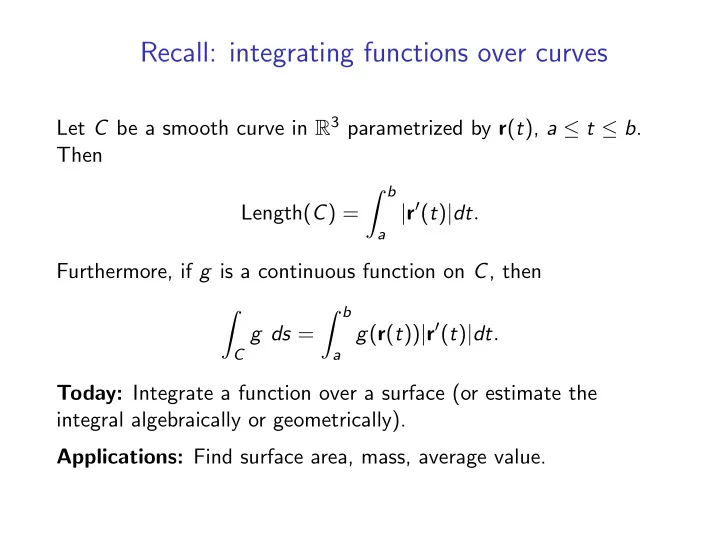

Recall: integrating functions over curves Let C be a smooth curve in R 3 parametrized by r ( t ), a ≤ t ≤ b . Then ∫︂ b | r ′ ( t ) | dt . Length( C ) = a Furthermore, if g is a continuous function on C , then ∫︂ b ∫︂ g ( r ( t )) | r ′ ( t ) | dt . g ds = C a Today: Integrate a function over a surface (or estimate the integral algebraically or geometrically). Applications: Find surface area, mass, average value.
Practice with surface area Find the surface area of S = { x 2 + y 2 + z 2 = 1 } . Step 1: Parametrize S r ( φ, θ ) = ⟨ sin φ cos θ, sin φ sin θ, cos φ ⟩ , 0 ≤ φ ≤ π ; 0 ≤ θ ≤ 2 π. Step 2: Calculate | r φ × r θ | . r φ ( φ, θ ) = ⟨ cos φ cos θ, cos φ sin θ, − sin φ ⟩ ; r θ ( φ, θ ) = ⟨− sin φ sin θ, sin φ cos θ, 0 ⟩ .
So ⃒ ⃒ i j k ⃒ ⃒ ⃒ ⃒ r φ × r θ = cos φ cos θ cos φ sin θ − sin φ ⃒ ⃒ ⃒ ⃒ − sin φ sin θ sin φ cos θ 0 ⃒ ⃒ = i (sin 2 φ cos θ ) − j ( − sin 2 φ sin θ ) + k (sin φ cos φ cos 2 θ + sin φ cos φ sin 2 θ ) = ⟨ sin 2 φ cos θ, sin 2 φ sin θ, sin φ cos φ ⟩ . Therefore √︂ sin 4 φ (cos 2 θ + sin 2 θ ) + sin 2 φ cos 2 φ | r φ × r θ | = √︂ sin 2 φ (sin 2 φ + cos 2 φ ) = √︂ sin 2 φ = sin φ = (since sin φ ≥ 0 on D ).
So the surface area of the sphere is ∫︂ 2 π ∫︂ π ∫︂∫︂ | r φ × r θ | dA = sin φ d φ d θ D 0 0 = 2 π [ − cos φ ] π 0 = 4 π.
Practice with surface area Consider a can with sides given by the cylinder { x 2 + y 2 = 1 , − 1 ≤ z ≤ 1 } , parametrized by r ( θ, z ) = ⟨ cos θ, sin θ, z ⟩ , 0 ≤ θ ≤ 2 π, − 1 ≤ z ≤ 1 . Find the surface area of the can. (Don’t forget the top and bottom!) (a) 2 π (b) 4 π (c) 6 π (d) 8 π (e) I don’t know how.
Solution First let’s calculate the area of the cylinder, and then we’ll add the top and bottom.We use the parametrization given above, r ( θ, z ) = ⟨ cos θ, sin θ, z ⟩ , 0 ≤ θ ≤ 2 π, − 1 ≤ z ≤ 1 . Step 2: Find | r θ × r z | . r θ ( θ, z ) = ⟨− sin θ, cos θ, 0 ⟩ ; r z ( θ, z ) = ⟨ 0 , 0 , 1 ⟩ . So ⃒ ⃒ i j k ⃒ ⃒ ⃒ ⃒ r θ × r z = − sin θ cos θ 0 = i cos θ + j sin θ, ⃒ ⃒ ⃒ ⃒ 0 0 1 ⃒ ⃒ and | r θ × r z | = 1.
So the surface area of the cylinder is ∫︂ 2 π ∫︂ 1 dzd θ = 4 π. 0 − 1 The top and the bottom of the can are each circles of radius one and hence have (surface) area π , so the total area is 4 π + π + π = 6 π.
Recommend
More recommend